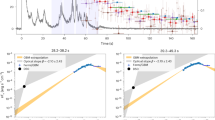Abstract
THERE are many models for the observed γ-ray bursts1, but none has proved entirely satisfactory. Here we suggest another possible model: that the γ rays are produced by inverse Compton processes occurring deep in the ergosphere of a fast rotating, accreting, black hole. At the time of burst, plasma, which has an optical depth of the order of the relevant gravitational distances, emerges near the horizon due to an instability, and free falling photons, which are produced by viscous processes in an accretion disk further away, are being scattered off it. In this model the black hole itself is probably a member of a binary system, and, depending on its steady-state accretion rate, may or may not be observable as an X-ray source.
This is a preview of subscription content, access via your institution
Access options
Subscribe to this journal
Receive 51 print issues and online access
$199.00 per year
only $3.90 per issue
Buy this article
- Purchase on Springer Link
- Instant access to full article PDF
Prices may be subject to local taxes which are calculated during checkout
Similar content being viewed by others
References
Ruderman, M., Proc. seventh Texas Symposium (in the press).
Piran, T., Shaham, J., and Katz, J., Astrophys. J. Lett., 196, L107–L108 (1975).
Thorne, K. S., Astrophys. J., 191, 597–619 (1974).
Cline, T. L., and Desai, U. D., Astrophys. J. Lett., 196, L43–L46 (1975).
Tananbaum, H., et al., Astrophys. J. Lett., 177, L5–L10 (1972).
Pringle, J. E., and Rees, M. J., Astr. Astrophys., 21, 1–9 (1972).
Lightman, A. P., and Eardly, D. M., Astrophys. J. Lett., 187, L1–L3 (1974).
Lamb, D. Q., Lamb, F. K., and Pines, D., Nature phys. Sci., 246, 52–54 (1973).
Palumbo, G. G. C., et al., Astrophys. J. Lett., 189, L9–L11 (1974).
Strong, I. B., and Klebesadel, R. W., Nature, 251, 396–397 (1974).
Thorne, K. S., and Price, R. H., Astrophys. J. Lett., 195, L101–L106 (1975).
Author information
Authors and Affiliations
Rights and permissions
About this article
Cite this article
PIRAN, T., SHAHAM, J. Can soft γ-ray bursts be emitted by accreting black holes?. Nature 256, 112–113 (1975). https://doi.org/10.1038/256112a0
Received:
Accepted:
Issue Date:
DOI: https://doi.org/10.1038/256112a0
This article is cited by
-
Galactic halo gamma rays
Nature (1991)
Comments
By submitting a comment you agree to abide by our Terms and Community Guidelines. If you find something abusive or that does not comply with our terms or guidelines please flag it as inappropriate.



